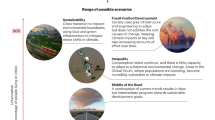Abstract
HENSHAW1 has accepted Coope's premise2 that giraffes have retained the skin-covered horn-like structures of the palaeomerycids, from which they are descended, because there have been no significant changes in the climate—the hypothesis being that the formation of antlers is a response to environmental temperatures. But the nature of the giraffe horn can be seen in relation to the form of the animal and its social requirements, without any reference to the cervid antler3. As Henshaw states, the horn-like structures of the giraffe are analogous to the summer antlers of deer, in that they have points of resemblance, but there is no justification for invoking climate as an explanation of their form. They are specialized structures in the giraffe Giraffa camelopardalis L. of which the skin covering is no more velvet-like than that covering the rest of the animal's body, and it is certainly not vascular like the velvet skin of antler buds.
This is a preview of subscription content, access via your institution
Access options
Subscribe to this journal
Receive 51 print issues and online access
$199.00 per year
only $3.90 per issue
Buy this article
- Purchase on Springer Link
- Instant access to full article PDF
Prices may be subject to local taxes which are calculated during checkout
Similar content being viewed by others
References
Henshaw, J., Nature, 224, 1036 (1969).
Coope, G. R., Deer, 1, 215 (1968).
Spinage, C. A., E. Afr. Wildl. J., 6, 53 (1968).
Author information
Authors and Affiliations
Rights and permissions
About this article
Cite this article
SPINAGE, C. Giraffid Horns. Nature 227, 735–736 (1970). https://doi.org/10.1038/227735a0
Received:
Issue Date:
DOI: https://doi.org/10.1038/227735a0
This article is cited by
-
Antlers—the Unbrittle Bones of Contention
Nature (1971)
Comments
By submitting a comment you agree to abide by our Terms and Community Guidelines. If you find something abusive or that does not comply with our terms or guidelines please flag it as inappropriate.



